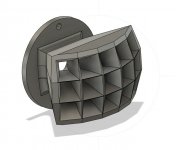I would like to try out a small single piece 3D printed multicell for a 1" CD as a tweeter for the large 5x3 multicell that is now waiting in my basement to be measured (some pictures here: https://www.diyaudio.com/forums/multi-way/136964-construction-multicell-horn-47.html). I would like to make a baby-multicell to match the visual style.
The Altec 601 horn is a 900 Hz cutoff, 3x2 cells, 60x40 coverage and around 10-12 cm width estimated from the pictures. It should be relatively simple to make a model of it, if I could get the dimensions more precise.
However, I am not sure if that is what I need. To match a 5x3 multicell with 12 cm cell size for use around 3 kHz and up, what would be some good dimensions to start with? Should it be a 5x3 cells, too?
The Altec 601 horn is a 900 Hz cutoff, 3x2 cells, 60x40 coverage and around 10-12 cm width estimated from the pictures. It should be relatively simple to make a model of it, if I could get the dimensions more precise.
However, I am not sure if that is what I need. To match a 5x3 multicell with 12 cm cell size for use around 3 kHz and up, what would be some good dimensions to start with? Should it be a 5x3 cells, too?
If you want a little multi for a tweeter then matching the coverage of your midrange horn seems a good idea. Of course the higher you cross, the less it seems to matter.
There aren't a lot of examples to go by, unfortunately.
There aren't a lot of examples to go by, unfortunately.
FWIW,
Historically, for HF // UHF duty, JBL moved to 60x30 deg. patterns in their later K2 super-tweeters that use small horns.
That ( using a narrowing of pattern for the UHF ) matches my own experience that achieiving good imaging doesn't rely on having wide UHF patterns ( once one gets, say, over 10K ).
Quite the opposite ( IME with Fostex tweeters ) .
🙂
Historically, for HF // UHF duty, JBL moved to 60x30 deg. patterns in their later K2 super-tweeters that use small horns.
That ( using a narrowing of pattern for the UHF ) matches my own experience that achieiving good imaging doesn't rely on having wide UHF patterns ( once one gets, say, over 10K ).
Quite the opposite ( IME with Fostex tweeters ) .
🙂
I think I will just try to put one together in 3D and see how it looks like. 5x3 and something like 20 - 30 mm cell size should be a good start. I was actually inspired by these wonderfully looking ceramic multicell horns: Ceramic Multicell Horns pair for 1" HF driver Altec, JBL and others. - Audio Asylum Trader
Those are pretty, for sure.
What size would you make a simple expo horn the cover the range you want? I'd start there and break it up into cells.
What size would you make a simple expo horn the cover the range you want? I'd start there and break it up into cells.
Yes, that is how I do it - make a simple expo horn in Hornresp, then divide the area and export the profile. Just doing that now. Cells would be 6.67 cm long, 750 Hz cutoff for 1500 Hz crossover.
Cool. My one worry is - will you be able to print the walls at the throat thin enough? Considering it's a high frequency horn, you would want very thin cross sections there at the beginning - right?
The thinnest line is somewhere between 0.4 - 0.5 mm with a 0.4 mm nozzle. Now I am fighting (again) with the throat transition. I cannot force F360 to create a loft to my liking. I am trying to model the empty space of the horn to cut it out later from a solid block.
Don't know if anyone else around here ever compared multi-cellular horn sound with more open horn designs. Even for Altec 604, UREI Big Red Monitors used a custom horn mouth on the 604's that wasn't divided into cells. Of course, dividing up a horn into multiple cells gives more control over dispersion, but it always increased distortion to my ears.
I am doing in mostly for looks and the fun of it. For ultimate HF solution, I have either the ES horn by Joseph Crowe or an ATH4 generated waveguide. I am curious if I will like the multicell or not.
I'm around here and have compared normal and multi-cell for over 35 years. My choice is made. 😉 But that is a topic for another thread.
Very cool! For use above 2 kHz I would have used fewer cells, but since you are going to print it, why not? 🙂
Cells would be 6.67 cm long, 750 Hz cutoff for 1500 Hz crossover.
Hmm, this doesn't seem right, I mean look at the 604-8G's path length;16" wide frame for scaling: http://www.lansingheritage.org/images/altec/catalogs/1975-home/page13.jpg
It looks like this is about 75mm deep X 95mm wide. Is that correct? Modeling it as a single expo horn in Hornresp would be enlightening.
OK, I checked at a couple of online 3D printing places and it's a little larger than I thought. It could be printed for as little as $130 here in the USA. Not too bad for a custom horn.
It is certainly not true to the original. It is just inspired by the looks of it.
Understood, but I'm questioning the dims based on the stated '6.67 cm long 750 Hz cutoff for 1500 Hz crossover', keeping in mind that this smaller than original horn is just a WG and originally spec'd. with a 2 kHz XO, though TTBOMK was never released for [general] sale: https://www.technicalaudio.com/pdf/...Altec_604/604_Models_Summary_Gary_R_Jones.pdf
Last edited:
- Home
- Loudspeakers
- Multi-Way
- Altec 601/604-like multicell horn dimensions and parameters - please advise
